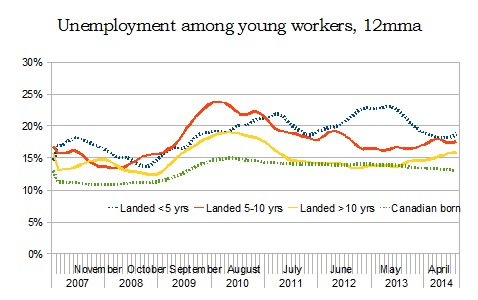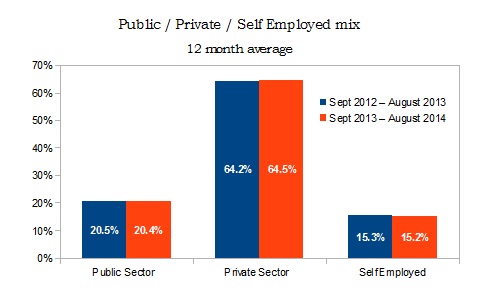Terrible, Horrible, No Good, Very Bad Job Numbers
Today Statistics Canada released their first set of job numbers since the ‘oops’ of July 2014. And the news was dismal. The labour market shed 112,000 private sector positions, the largest single month drop in the private sector since, well, forever. Coming on the heels of a mistake is unfortunate, but you have to think that Statistics Canada was extra vigilant this month and checked everything up, down, backwards, and sideways.
Either way, month to month variations are far less meaningful than overall trends, so let’s have a look at those, shall we?
Part-time work
Only workers over 55 have seen an increase in full time work compared to last August, and most of this is likely due to demographic change. Among core age workers there were fewer full-time jobs and more part-time jobs. Young workers traded 3,000 full-time jobs for less than a thousand part-time ones.
Temporary work
The picture is quite similar for temporary employment. Year over year, core age workers saw a drop in the number of permanent jobs, and an increase in temporary employment. 
Young Workers
Young workers in particular have difficulty finding work when the labour market is slack. As do new Canadians. So it would follow that young workers who are also new Canadians have an even harder time. The graph below shows the unemployment rate for young workers as a 12 month moving average from January 2007.
At it’s peak, the unemployment rate for young workers who had been landed immigrants for 5 -10 years almost hit 25%. While the unemployment rate for Canadian born young workers remains elevated over its pre-recession level, the trend seems to be gradually falling. On the other hand, the unemployment rate is rising for all three categories of new Canadian young workers.
Public / Private mix
Such a huge drop in private sector employment is a concern, since the labour market has been very heavily relying on private sector gains for the minimal job growth we have seen this year. And the huge spike in self-employment is also worrisome, as these jobs are more often precarious ones.
The good news is that this months drop in private sector employment and spike in self-employment didn’t really change the overall mix when you look at the average over the past twelve months and compare this to the year before.
Â
With far too few job vacancies, and record low proportions of unemployed workers receiving EI (especially in urban areas), the Canadian labour market is looking pretty depressing. I think there’s going to be a lot to discuss at Unifor’s upcoming Good Jobs Summit in Toronto.




Letter in Toronto Star:
A new twist to fight joblessness
http://www.thestar.com/opinion/letters_to_the_editors/2014/09/12/a_new_twist_to_fight_joblessness.html
Re: Are we becoming a nation of part-timers? Opinion Sept. 8
Carol Goar seems to accept the conventional view that government should resolve our massive problem of joblessness (currently numbering 1.3 million Canadians) by inducing employers to create full-time jobs through wage and training subsidies, and tax relief. But there are more robust methods.
In days when Canada overproduced of wheat, government purchased a large quantity of it, creating a storage buffer stock that was released into the market over time when supplies ran low. The same can be done with excess workforce capacity.
The government through an Employer of Last Resort program could put people to work on community and environmental projects at minimum livable wage, until such time as private sector recovery would lure workers away with higher pay and better opportunities. The benefits of this type of program far outweigh the costs, and have been offered in many countries.
If our conventional Canadian economists and politicians cannot offer detailed, comprehensive prescriptions for ending high unemployment, then we have just another addition to their long list of failures.
___________________________________________
Footnotes to Letters Editor
Footnotes:
1. The Job Guarantee: A Government Plan for Full Employment
http://www.thenation.com/article/161249/job-guarantee-government-plan-full-employment
The benefits of full employment include production of goods, services and income; on-the-job training and skill development; poverty alleviation; community building and social networking; social, political and economic stability; and social multipliers (positive feedbacks and reinforcing dynamics that create a virtuous cycle of socioeconomic benefits). An “employer of last resort†program would restore the government’s lost commitment to full employment in recognition of the fact that the total impact would exceed the sum of the benefits.
2. The JG / ELR and Real World Experience
http://neweconomicperspectives.org/2012/04/mmp-blog-47-the-jg-elr-and-real-world-experience.html
In the aftermath of its economic crisis that came with the collapse of its currency board, Argentina created Plan Jefes y Jefas that guaranteed a job for poor heads of households. The program successfully created 2 million new jobs that not only provided employment and income for poor families, but also provided needed services and free goods to poor neighborhoods.